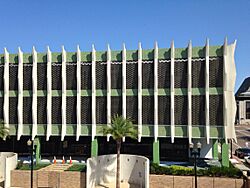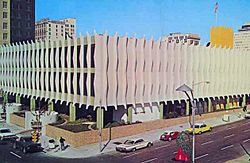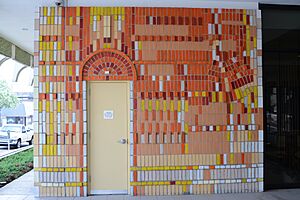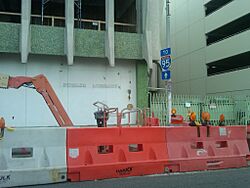Jessie Ball duPont Center facts for kids
Quick facts for kids Jessie Ball duPont Center |
|
|---|---|
 |
|
| Former names | Haydon Burns Library |
| General information | |
| Type | Class "A" office |
| Location | 122 Ocean Street |
| Coordinates | 30°19′38″N 81°39′25″W / 30.32731°N 81.65682°W |
| Construction started | 1964 |
| Completed | 1965 |
| Opening | 1965 |
| Cost | $3.7 million |
| Owner | Jessie Ball duPont Fund |
| Height | |
| Roof | 447 ft (136 m) |
| Technical details | |
| Floor count | 4 |
| Floor area | 122,000 sq ft (11,300 m2) |
| Lifts/elevators | 1 |
| Design and construction | |
| Architect | Taylor Hardwick |
| Developer | City of Jacksonville |
| Main contractor | The Auchter Company |
The Jessie Ball duPont Center is a special building in downtown Jacksonville, Florida. It's a place where many different non-profit groups work together.
For many years, from 1965 to 2005, this building was the main library for Jacksonville. It was called the Haydon Burns Library, named after W. Haydon Burns, who was the mayor of Jacksonville for 15 years and also the governor of Florida. Before this library, there was an older one built in 1905. In 2012, a group of architects in Florida named this building one of the top 100 architectural places in the state!
Contents
Building's History
When the building was finished in 1965, it cost $3.7 million. It was considered very modern for its time. The building has three floors and was designed by a local architect named Taylor Hardwick. He designed many buildings in Jacksonville, like the Skinner Dairy stores and Friendship Fountain.
A library expert named John Hall Jacobs also helped with the design. Taylor Hardwick spent five years planning the library. He even picked out all the furniture and decided how the books would be arranged. He chose bright colors and didn't use too much natural light. The walls around the main elevator are covered with colorful pictures made from 10,000 shiny bricks.
The ground floor has huge windows. This allows people walking by to see all the activity inside the library. The outside walls facing Ocean and Adams streets have 88 "fins." These fins stick out from the second floor all the way to the roof. They look a bit like piano keys! These fins help catch the wind and create shadows, which keeps the building cooler inside. The company that built the library was The Auchter Company from Jacksonville.
Why the Library Moved Out
The building served Jacksonville well for many years. But by the mid-1990s, it just wasn't big enough anymore. There wasn't enough parking, and the old wiring couldn't handle all the new technology libraries needed. About 300,000 people used the Burns library every year.
In 2000, people in Jacksonville voted to approve a plan to build a new downtown library. The Haydon Burns Library checked out its last book on September 3, 2005. It took several weeks to move the library's half-million books and other items to the new place. On November 12, 2005, the new Main Library opened to the public.
| Preceded by Carnegie Library (opened 1905) |
Downtown Public Library Haydon Burns Library 1965–2005 |
Succeeded by Main Library 2005 |
Finding a New Owner
After the library moved, the city wanted to sell the building. Many different groups were interested. One group wanted to tear it down and build apartments, but that plan didn't work out. Another company that makes chocolate wanted to turn it into a chocolate factory, but that didn't happen either.
Finally, a group called Main Branch LLC bought the building in 2007. They wanted to keep most of the building's original look. They planned to add more floors for apartments and have shops and restaurants inside. They even hoped to have a movie theater! However, a big economic downturn, called the Great Recession, stopped all their plans.
The building stayed empty for a while. Then, in 2012, things started to get better. The Jessie Ball duPont Fund became interested in buying the building.
A New Purpose: Helping Others
The Jessie Ball duPont Fund (JBDF) bought the building on June 19, 2013, for $2.2 million. This was $1 million less than the previous owners paid. The head of the JBDF, Sherry Magill, said the building would become a "philanthropic and nonprofit center." This means it would be a home for many different charities and non-profit groups.
The idea was that these groups could work together and help each other. They could also save money by sharing the building and buying things in bulk. Similar centers exist in other cities like Dallas, Texas and Wilmington, Delaware.
The Jessie Ball duPont Fund created a special company to own and manage the building. They wanted to offer affordable rent to non-profit groups. The building has 80,000 square feet of space for rent. It also has a huge basement that could be used in emergencies.
The JBDF also wanted to make the building very energy efficient. They planned to add features to save energy and get a special "LEED" certification. This shows that a building is environmentally friendly. They planned to spend $20 million on renovations. The work was expected to take about 18 months.
In May 2014, the inside of the building was almost ready for construction. The Jessie Ball duPont Center officially opened its doors in 2015.
See also
- Architecture of Jacksonville




